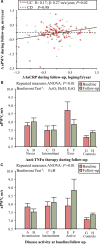Inflammation and Aortic Pulse Wave Velocity: A Multicenter Longitudinal Study in Patients With Inflammatory Bowel Disease
- PMID: 30712441
- PMCID: PMC6405571
- DOI: 10.1161/JAHA.118.010942
Inflammation and Aortic Pulse Wave Velocity: A Multicenter Longitudinal Study in Patients With Inflammatory Bowel Disease
Abstract
Background Inflammatory bowel disease ( IBD ) is characterized by a low prevalence of traditional risk factors, an increased aortic pulse-wave velocity ( aPWV ), and an excess of cardiovascular events. We have previously hypothesized that the cardiovascular risk excess reported in these patients could be explained by chronic inflammation. Here, we tested the hypothesis that chronic inflammation is responsible for the increased aPWV previously reported in IBD patients and that anti-TNFa (anti-tumor necrosis factor-alpha) therapy reduce aPWV in these patients. Methods and Results This was a multicenter longitudinal study. We enrolled 334 patients: 82 patients with ulcerative colitis, 85 patients with Crohn disease, and 167 healthy control subjects matched for age, sex, and mean blood pressure, from 3 centers in Europe, and followed them for 4 years (range, 2.5-5.7 years). At baseline, IBD patients had higher aPWV than controls. IBD patients in remission and those treated with anti-TNFa during follow-up experienced an aortic destiffening, whereas aPWV increased in those with active disease and those treated with salicylates ( P=0.01). Disease duration ( P=0.02) was associated with aortic stiffening as was, in patients with ulcerative colitis, high-sensitivity C-reactive protein during follow-up ( P=0.02). All these results were confirmed after adjustment for major confounders. Finally, the duration of anti-TNFa therapy was not associated with the magnitude of the reduction in aPWV at the end of follow-up ( P=0.85). Conclusions Long-term anti-TNFa therapy reduces aPWV , an established surrogate measure of cardiovascular risk, in patients with IBD . This suggests that effective control of inflammation may reduce cardiovascular risk in these patients.
Keywords: Crohn disease; arterial stiffness; inflammation; pulse wave velocity; tumor necrosis factor‐alpha; ulcerative colitis.
Figures


Similar articles
-
Inflammation and Aortic Stiffness: An Individual Participant Data Meta-Analysis in Patients With Inflammatory Bowel Disease.J Am Heart Assoc. 2017 Oct 10;6(10):e007003. doi: 10.1161/JAHA.117.007003. J Am Heart Assoc. 2017. PMID: 29018026 Free PMC article. Review.
-
Increased arterial stiffness in inflammatory bowel diseases is dependent upon inflammation and reduced by immunomodulatory drugs.Atherosclerosis. 2014 Jun;234(2):346-51. doi: 10.1016/j.atherosclerosis.2014.03.023. Epub 2014 Mar 30. Atherosclerosis. 2014. PMID: 24732573
-
Lower-extremity arterial stiffness vs. aortic stiffness in the general population.Hypertens Res. 2013 Aug;36(8):718-24. doi: 10.1038/hr.2013.21. Epub 2013 Apr 11. Hypertens Res. 2013. PMID: 23575382
-
Pulse wave velocity measurement as a marker of arterial stiffness in pediatric inflammatory bowel disease: a pilot study.Eur J Pediatr. 2017 Jul;176(7):983-987. doi: 10.1007/s00431-017-2927-7. Epub 2017 May 15. Eur J Pediatr. 2017. PMID: 28508156 Clinical Trial.
-
Aortic Stiffening Is an Extraintestinal Manifestation of Inflammatory Bowel Disease: Review of the Literature and Expert Panel Statement.Angiology. 2020 Sep;71(8):689-697. doi: 10.1177/0003319720918509. Epub 2020 Apr 15. Angiology. 2020. PMID: 32292048 Review.
Cited by
-
Vascular Aging and Central Aortic Blood Pressure: From Pathophysiology to Treatment.High Blood Press Cardiovasc Prev. 2020 Aug;27(4):299-308. doi: 10.1007/s40292-020-00395-w. Epub 2020 Jun 22. High Blood Press Cardiovasc Prev. 2020. PMID: 32572706 Review.
-
Children with inflammatory bowel disease already have an altered arterial pulse wave.Eur J Pediatr. 2023 Apr;182(4):1771-1779. doi: 10.1007/s00431-023-04858-9. Epub 2023 Feb 10. Eur J Pediatr. 2023. PMID: 36763192
-
What Links an Increased Cardiovascular Risk and Inflammatory Bowel Disease? A Narrative Review.Nutrients. 2021 Jul 30;13(8):2661. doi: 10.3390/nu13082661. Nutrients. 2021. PMID: 34444821 Free PMC article. Review.
-
Cardiovascular Manifestations in Inflammatory Bowel Disease.Curr Cardiol Rev. 2023 Nov 24;20(1):E241123223802. doi: 10.2174/011573403X256094231031074753. Online ahead of print. Curr Cardiol Rev. 2023. PMID: 38018203 Free PMC article.
-
Abdominal Aortic Endothelial Dysfunction Occurs in Female Mice With Dextran Sodium Sulfate-Induced Chronic Colitis Independently of Reactive Oxygen Species Formation.Front Cardiovasc Med. 2022 Apr 7;9:871335. doi: 10.3389/fcvm.2022.871335. eCollection 2022. Front Cardiovasc Med. 2022. PMID: 35463755 Free PMC article.
References
-
- Geerling BJ, Badart‐Smook A, Stockbrugger RW, Brummer RJ. Comprehensive nutritional status in recently diagnosed patients with inflammatory bowel disease compared with population controls. Eur J Clin Nutr. 2000;54:514–521. - PubMed
-
- Levy E, Rizwan Y, Thibault L, Lepage G, Brunet S, Bouthillier L, Seidman E. Altered lipid profile, lipoprotein composition, and oxidant and antioxidant status in pediatric Crohn disease. Am J Clin Nutr. 2000;71:807–815. - PubMed
-
- Jahnsen J, Falch JA, Mowinckel P, Aadland E. Body composition in patients with inflammatory bowel disease: a population‐based study. Am J Gastroenterol. 2003;98:1556–1562. - PubMed
-
- Yarur AJ, Deshpande AR, Pechman DM, Tamariz L, Abreu MT, Sussman DA. Inflammatory bowel disease is associated with an increased incidence of cardiovascular events. Am J Gastroenterol. 2011;106:741–747. - PubMed
-
- Harbord M, Annese V, Vavricka SR, Allez M, de Barreiro‐Acosta M, Boberg KM, Burisch J, De Vos M, De Vries AM, Dick AD, Juillerat P, Karlsen TH, Koutroubakis I, Lakatos PL, Orchard T, Papay P, Raine T, Reinshagen M, Thaci D, Tilg H, Carbonnel F; European Crohn's and Colitis Organisation . The first European evidence‐based consensus on extra‐intestinal manifestations in inflammatory bowel disease. J Crohns Colitis. 2016;10:239–254. - PMC - PubMed
Publication types
MeSH terms
Substances
LinkOut - more resources
Full Text Sources
Research Materials

